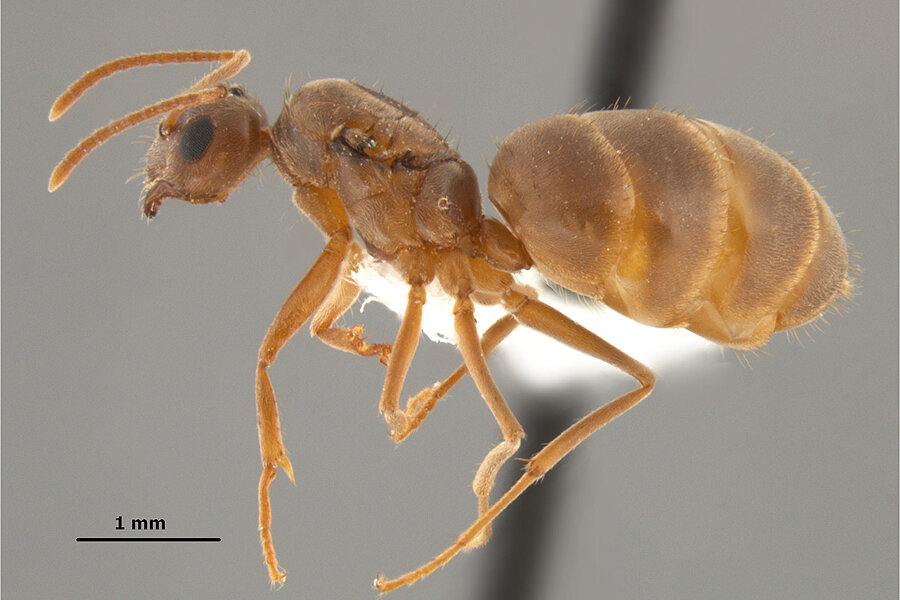Exactly how much force does it take to rip an ant's head off? New research offers clues.
Loading...
While the world watches Olympians skate, jump and fly through the air in Sochi, researchers have turned their eyes to a much tinier but equally impressive athlete: the humble field ant.
New research published last month showed that the neck joint of a common field ant can withstand 5,000 times the ant’s weight. Previously, ants had been photographed carrying dead baby birds, so it was estimated they could carry around 1,000 times their weight. But the new numbers surprised even the researchers.
“We guessed that the ants could withstand about 1,000 times their weight, so we figured we’d start there,” said Carlos Castro, a mechanical and aerospace engineer at The Ohio State University in Columbus. “Initially we didn’t think this ant had any extreme capabilities, but they surprised us.”
Testing the ants' strength involved extreme and destructive measures.
Castro and his colleagues anesthetized common field ants and glued their heads to a centrifuge about the size of a compact disc. As the disc spun faster and faster, the forces applied to the ants increased – until their necks deformed, and their heads separated from their bodies at the tiny neck joint.
“We had to put a Plexiglas barrier around the centrifuge to protect the grad students,” said Castro, “because the ant bodies would go flying at the moment of rupture.” The ants’ necks ruptured when the centrifuge applied forces of 3,400 to 5,000 times their average body weight.
In addition to the centrifugal studies, Castro used microcomputed tomography to reconstruct a 3-D model of the ant’s neck joint.
He found that the surface of the ant’s neck had a microstructure of bumps and folds that helped the ants shoulder large loads.
“From a materials standpoint, we found that the properties themselves are similar to other insects,” said Castro. “We think it’s this design rather than material design that helps the ants.”
The full research was published in late January in the Journal of Biomechanics.
Other researchers noted that while ants are certainly strong, the research doesn't necessarily show how much weight than can actually lift and carry.
Karin Moll, a biologist and ant researcher at University College Freiburg in Germany who was not involved in the research, said that the 5,000 mark is impressive, but that it doesn’t necessarily mean that the ants could lift that amount. “The authors showed that the ants can hold that amount, but this situation is different from carrying a load…loads that are actually carried are usually much smaller,” Moll wrote in an email to Inside Science.
Thomas Endlein, a researcher at the University of Glasgow who has studied the sticky pads on ants’ feet, added that lifting large weights is problematic for several reasons -- including the muscle strength, the structural stiffness and balance.
“Muscle strength is often not a problem as smaller animals have relatively more muscle strength to their body weight compared to larger animals,” he wrote in an email to Inside Science. “Still, balancing the weights is a big problem. First, ants have to lever off the weights from the ground which is a tricky business if items are oddly shaped or heavy…then, balancing the item overhead when walking, [it] is also very tricky to avoid falling over.”
Mike Kaspari, a biologist at the University of Oklahoma, said that microbotics – the blending of biology and engineering to build tiny semi-smart animatrons – is one of the most exciting new technologies. “The hope is that these cheap microbots can explore, monitor, and fix our environment, as well as perform other tasks through sheer force of numbers,” he said. “This is another lovely example of how engineers look to the ant to inspire their designs.”
Castro said that the research could be applied to creating robots that could lift and carry more efficiently, taking a nod from the ants’ hybrid soft-hard components. Researchers could also create better composite materials using the combination approach of soft and hard.
He also plans to study more ants from a mechanical point of view by looking at their musculature, and also at ants with different roles within the same species. “We really chose an everyday ant,” he said. “The most optimized ants may be able to withstand forces of 10,000 times their weight.”
Katharine Gammon (@kategammon) is a freelance science writer based in Santa Monica, Calif., and writes for a wide range of magazines covering technology, society, and animal science.
Originally posted on Inside Science.







